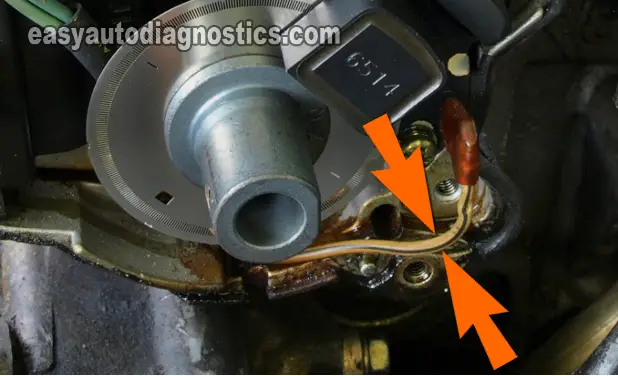TEST 2: Testing The Power Transistor's Triggering Signal

In this test step, you're gonna' check that the power transistor (igniter) is getting the Triggering signal from the fuel injection computer or not.
This Triggering signal can be very easily and accurately tested using a simple automotive LED light. If you need to see what this LED light looks like, you can see it here: The LED Light Test Tool And How To Make One.
NOTE: The distributor must remain connected to its electrical connector for this test to work. To check for the power transistor's activation signal within the wire, you'll need to use a back probe on the connector or a wire piercing probe on the wire. You can see an example of this tool here: Wire Piercing Probe.
OK, this is what you need to do:
- 1
Reconnect the distributor to its electrical connector.
- 2
Connect the red lead of the LED to the wire labeled with the number 1 using an appropriate tool (like a wire piercing probe).
- 3
Next, connect the black lead of the LED light to the battery negative (-) terminal.
- 4
When you have everything set up, have your helper crank the engine as you observe the LED light.
- 5
The LED light should blink ON and OFF the whole time your helper is cranking the engine.
Let's examine your test result:
CASE 1: The LED light blinked ON and OFF. This is the normal and expected test result and tells you that the fuel injection computer is triggering (activating) the power transistor.
The next step is to check that the power transistor is producing a Switching signal for the ignition coil, go to: TEST 3: Making Sure The Ignition Coil Is Getting Activation Signal.
CASE 2: The LED light DID NOT blink ON and OFF. Without this Triggering signal, from the fuel injection computer, the power transistor will not work.
Although it's beyond the scope of this tutorial to troubleshoot the cause of this missing triggering signal, the most likely cause of this missing power transistor activation signal is a bad camshaft position sensor.
To check the camshaft position sensor, see this tutorial: How To Test The Camshaft Position Sensor 2.4L Nissan Altima (1997-2001).
TEST 3: Making Sure The Ignition Coil Is Getting Activation Signal

The purpose of the power transistor is to activate the ignition coil. It does this by interrupting the coil's power supply (which in tech speak is called the Primary Current).
So, in this test step, you're gonna' check to see if the power transistor is creating this activation signal (referred to as the Switching signal) using the same LED light that you used in TEST 2.
NOTE: The distributor must remain connected to its electrical connector for this test to work. To check for the ignition coil's activation signal within the wire, you'll need to use a back probe on the connector or a wire piercing probe on the wire. You can see an example of this tool here: Wire Piercing Probe.
OK, now for this test, this is what you need to do:
- 1
Remove the plastic dust cap that is underneath the distributor rotor.
To be a little more specific, this is the plastic protective cap that protects all of the wires and the power transistor inside the distributor and that can be removed by first removing the distributor rotor and then the two little screws that hold it in place.
NOTE: It's not necessary to remove the distributor from the car to remove this dust cap. Once you've removed the dust cap, your distributor should look like the one in the photo. - 2
Connect the black lead of the LED to the wire labeled with the orange arrow, using an appropriate tool (like a wire piercing probe).
- 3
Next, connect the red lead of the LED light to the battery positive (+) terminal.
- 4
When you have everything set up, have your helper crank the engine as you observe the LED light.
- 5
The LED light should blink ON and OFF the whole time your helper is cranking the engine.
Let's examine your test result:
CASE 1: The LED light DID NOT blink ON and OFF. This test result confirms that the power transistor is not producing an ignition coil activation signal.
You can conclude that the power transistor is bad and needs to be replaced if you have:
- Confirmed that the power transistor is getting power (TEST 1).
- Confirmed that the power transistor is getting an activation signal (Triggering signal) from the fuel injection computer (TEST 2).
Here's why: If the power transistor is receiving 12 Volts and an activation signal, then it has to produce an activation signal for the ignition coil. Since it isn't, and you have confirmed that it's getting 12 Volts and its Triggering signal, then you can conclude that it's defective and needs to be replaced.
Since the power transistor is not sold separately, you'll need to replace the entire distributor with a new one.
CASE 2: The LED light blinked ON and OFF. This result tells you that the power transistor is working and creating the ignition coil's Switching signal.
This result also confirms that the power transistor is not the cause of the no-spark no-start condition on your 2.4L Nissan Altima.

If this info saved the day, buy me a beer!


